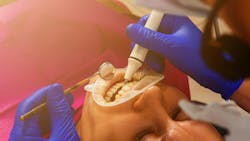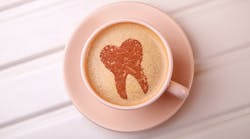The importance of extrinsic stain removal during dental cleanings
In preventive and therapeutic dental care, removing extrinsic stains during cleanings is often perceived as a cosmetic add-on. However, research highlights the significance of stain removal in promoting overall oral health. Beyond esthetics, stain removal prevents the colonization of harmful bacteria and maintains the integrity of the tooth surface and surrounding periodontal tissues.
Stains and bacterial adherence
Extrinsic stains on teeth, commonly caused by dietary habits, tobacco use, and poor oral hygiene, create a substrate for bacterial attachment. Stains, particularly those from chromogenic bacteria, can bind to the protective dental pellicle, which makes it more challenging to remove and more resistant to oral hygiene measures.1
The adherence of stain to the dental pellicle leads to a rough surface, which increases the retention of dental plaque, and plaque is a key factor in the development of dental caries and periodontal diseases.2 By removing stains, clinicians can disrupt this cycle, which reduces the bacterial load and helps prevent the progression of caries and periodontal disease.
Impact on periodontal health
Periodontal health is intricately linked to biofilm on the tooth surface.3 Stains ingrained in and around the gingival margin can contribute to gingival inflammation and periodontal disease progression.4 During a dental cleaning, thorough stain removal can reduce plaque accumulation along the sulcus and gingival margin, preventing gingivitis and periodontitis.
Patients who receive regular professional cleanings that include stain removal have a lower prevalence of periodontal disease and tooth loss.4 By addressing extrinsic stains, we can help maintain periodontal health and safeguard the natural dentition.
Stain removal and patient perception
Patient perception plays a pivotal role in dental care. Stain removal enhances the appearance of the teeth while increasing patient satisfaction and adherence to recommended oral hygiene practices. Patients who observe visible improvements in their oral health and esthetics are more likely to maintain their hygiene routines and attend regular dental visits.5 This reduces the incidence of future stain formation and associated oral health issues.
The role of clinicians
For clinicians, stain removal should be a standard component of preventive and therapeutic cleanings. Neglecting to remove stains can leave behind rough surfaces that harbor biofilm, potentially reducing the effectiveness of the cleaning. By ensuring the complete removal of extrinsic stains, clinicians enhance clinical outcomes and promote long-term oral health for their patients.
Conclusion
Stain removal during dental cleanings is a critical step in preventing the accumulation of biofilms and the progression of periodontal disease. It should not be perceived as just a cosmetic procedure, as it plays a fundamental role in maintaining the health of the tooth surface and surrounding tissues.
We should prioritize stain removal as part of our comprehensive dental care to improve patient satisfaction and support long-term oral health outcomes. By doing so we effectively disrupt bacterial colonization, promote periodontal health, and enhance patient adherence to oral hygiene practices. This approach contributes to the overarching goal of preventive and therapeutic dentistry: preserving natural teeth and ensuring optimal oral health throughout a patient's life.
References
1. Enax J, Ganss B, Amaechi BT, Schulze Zur Wiesche E, Meyer F. The composition of the dental pellicle: an updated literature review. Front Oral Health. 2023;11(4):1260442. doi:10.3389/froh.2023.1260442
2. Loesche WJ. Microbiology of dental decay and periodontal disease. 4th edition. University of Texas Medical Branch at Galveston. 1996. https://www.ncbi.nlm.nih.gov/books/NBK8259/
3. Deo PN, Deshmukh R. Oral microbiome: unveiling the fundamentals. J Oral Maxiofac Pathol. 2019;23(1):122-128. doi:10.4103/jomfp.JOMFP_304_18
4. Könönen E, Gursoy M, Gursoy UK. Periodontitis: a multifaceted disease of tooth-supporting tissues. J Clin Med. 2019;8(8):1135. doi:10.3390/jcm8081135
5. Mueller M, Schorle S, Vach K, Hartmann A, Zeeck A, Schlueter N. Relationship between dental experiences, oral hygiene education and self-reported oral hygiene behaviour. PloS One. 2022;17(2):e0264306. doi:10.1371/journal.pone.0264306
About the Author

Brittany Cox, MA, RDH
Brittany Cox, MA, RDH, is a sustainable systems strategist and policy architect guiding health care toward a planet-first future. With a background in oral health promotion, leadership, and coaching, she helps dental practices and institutions cut waste, improve care, and operate more sustainably. Now studying environmental and health law, she’s expanding her impact through policy. Known for turning complex challenges into clear strategy, Brittany empowers leaders to do better by their patients, people, and the planet. Brittany can be reached at [email protected].


